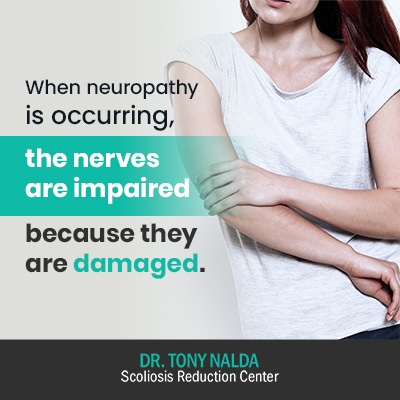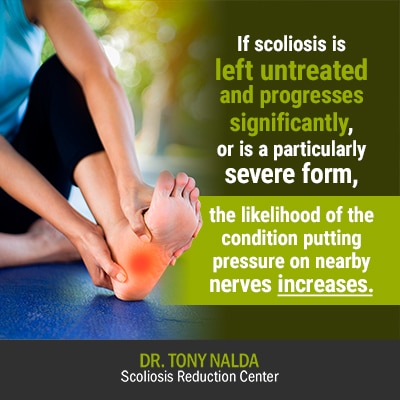While scoliosis is a spinal condition, its effects can be felt in multiple areas of the body. This is because, as part of the central nervous system, the spine works with the brain to facilitate communication throughout the body.
When scoliosis develops, the spinal curvature introduces adverse spinal tension, which can cause compression of the spine and its surrounding muscles, vessels, and nerves. Scoliosis, like any condition affecting the central nervous system, has the potential to cause tingling, numbness, and neuropathy.
Before we move on to the specifics of how scoliosis can cause feelings of tingling and numbness, let’s first define neuropathy and how it can affect the body.
What’s Neuropathy?
Also known as ‘peripheral neuropathy’, neuropathy is damage or impairment of one or more nerves, known to cause feelings of tingling, numbness, muscle weakness and discomfort in the affected area.
Most often, neuropathies start in the hands and feet, but other parts and areas of the body can also be affected.
The body’s nervous system consists of two main parts: the peripheral nervous system (PNS) and the central nervous system (CNS). The PNS consists of the brain and cranial nerves connecting to the brain and spinal cord. The CNS is the body’s ‘control center’ and consists of the brain and spinal cord.
The nervous system is a vast network of cells and nerves that connect the brain and spinal cord to the rest of the body through the passing of signals; this would include signals to the arms, hands, legs, feet, internal organs, muscles, mouth and face.
The PNS has the all-important task of facilitating communication about physical sensations with the brain.

When neuropathy is occurring, the nerves are impaired because they are damaged. This type of impairment disrupts the normal functioning of the nerves, sending incorrect signals and messages. They might send pain signals where there is no actual pain, or they might not send pain signals when there is an actual source of pain.
Neuropathy can be an uncomfortable and unpredictable disorder. When it comes to treatment, the most important thing is to determine its underlying cause.
Some causes of neuropathy include an illness, injury, infection, or an underlying condition.
Types of Neuropathy
There are more than a hundred different types of peripheral neuropathy, each with its own unique symptoms, causes, and treatment options.
Neuropathies are further classified based on the type of nerve damage involved. ‘Mononeuropathy’ refers to types where there is only damage to one nerve; ‘polyneuropathy’ is more common and occurs when multiple nerves have been damaged.
Symptoms of Peripheral Neuropathy
There are three main types of peripheral nerves; they are sensory nerves that connect to the skin, motor nerves that connect to the muscles, and autonomic nerves that connect to the body’s internal organs. Neuropathy has the potential to affect one of these nerve groups, or all three.
At the onset of neuropathy, symptoms can be vague and indicate numerous other conditions. Symptoms can vary and will largely depend on the condition’s underlying cause, in addition to which nerves are facing damage.
Symptoms of Sensory Neuropathy
As the sensory nerves connect to the skin, they would involve sensations of touch and temperature.
Symptoms of sensory neuropathy can include:
- Feelings of numbness, burning, and/or tingling in the hands and feet
- Strange sensations (paresthesias)
- Loss of reflexes
- Lack of coordination
- Pain
- Not being able to feel pain, temperature changes, and/or touch
Symptoms of Motor Neuropathy
Motor nerves send signals from the brain to the muscles of the body, helping the brain to control the muscles and movement.
Symptoms of motor neuropathy can include:
- Muscle weakness
- Loss of muscle control
- Muscle twitches
- Muscle cramps
- Muscle spasms
- Issues with coordination and balance
- Difficulty with movement and/or moving limbs
Symptoms of Autonomic Neuropathy
The autonomic nerves perform important functions such as controlling heart rate, digestion, and breathing.
Symptoms of autonomic neuropathy can include:
- Fainting spells
- Dizziness
- Nausea and/or vomiting
- Diarrhea
- Abnormal blood pressure and/or heart rate
- Sexual dysfunction
As you can see, there is a wide range of symptoms associated with neuropathy, which is why it’s so important to discuss any and all symptoms with your doctor as many of these symptoms are indicators of other conditions.
As is always the case, treatment only has potential efficacy when the underlying condition causing the symptoms is addressed and treated, rather than just addressing and treating its symptoms.
Neuropathy symptoms can progress quickly and then slow down, and in chronic neuropathies, there can be marked periods of relapse and remission.
Approximately 30 percent of neuropathy cases are caused by diabetes, and between 30 and 40 percent are classified as idiopathic, meaning there is no single-known cause.
Now that we have a thorough understanding of neuropathy and its effects on the body, let’s take a look at scoliosis and how the spinal condition can impact nerves and cause numbness.
What is Scoliosis?
Scoliosis is defined as a spinal condition characterized by an abnormal sideways spinal curvature, with rotation, and a minimum Cobb angle measurement of 10 degrees.
A patient’s Cobb angle measurement is obtained via X-ray and measures how far out of a healthy and natural alignment a scoliotic spine is. The higher the Cobb angle, the more severe the condition is:
- Mild scoliosis: Cobb angle measurement between 10 and 25 degrees
- Moderate scoliosis: Cobb angle measurement between 25 and 40 degrees
- Severe scoliosis: Cobb angle measurement of 40+ degrees
- Very-severe scoliosis: Cobb angle measurement of 80+ degrees
There are a lot of uneven forces at work with scoliosis. In the condition’s most common form (adolescent idiopathic scoliosis), it’s postural changes to the back, hips, shoulders and shoulder blades that can give the body an overall asymmetrical appearance and signal the condition’s presence; in adults, it’s most often pain that alerts them to the condition’s presence and leads to a diagnosis.
While every case is different and unique to the patient, generally speaking, the more severe a condition is, the more likely it is to produce noticeable symptoms such as pain, postural changes, and nerve issues; that being said, some individuals don’t experience noticeable neurological symptoms.
Scoliosis and the Nervous System
The spine plays many important roles. Not only does it facilitate movement, flexibility, and help us to maintain a straight and upright posture, it also houses the spinal cord.
The spinal cord is made up of a bundle of nerves that facilitates communication between the brain and the rest of the body. If scoliosis has changed the positioning of the spine significantly, as it can in severe forms, this can interrupt nervous-system activity.
It is, however, important to note that as scoliosis varies so much in severity, mild and moderate cases aren’t generally known to cause many functional deficits, including affecting the nervous system.
Can Scoliosis Cause Numbness?

If scoliosis is left untreated and progresses significantly, or is a particularly severe form, the likelihood of the condition putting pressure on nearby nerves increases. When this happens, scoliosis can cause numbness in various parts of the body as the condition can interfere with the nervous system.
This can also involve feelings of tingling, weakness, and/or pain in affected parts of the body, most commonly the lower extremities such as the legs and feet. In some severe and very-severe cases, the compression of the nerves can impair a patient’s ability to walk normally and control their limbs.
Pain is much more commonly a part of the adult experience of scoliosis; in fact, it’s most often back pain and/or pain that radiates into the legs and feet that leads many adults to a scoliosis diagnosis.
Depending on where the pinched nerves are located, scoliosis also has the potential to impact bladder and bowel function: another sign that scoliosis is affecting the nervous system.
Scoliosis also has the potential to indirectly cause nerve damage by contributing to the development of other spinal conditions that impact the nerves, such as spinal stenosis.
Spinal Stenosis
Scoliosis can also lead to spinal stenosis, which can cause numbness and pain. As scoliosis affects the overall health of the spine, it can potentially lead to the development of a number of spinal conditions, especially if left untreated.
Degenerative scoliosis and/or osteoarthritis of the spine (which scoliosis also contributes to) can lead to spinal stenosis.
Spinal stenosis is when one or more of the openings within the spine start to narrow, reducing the space for the nerves housed within. Depending on how much narrowing develops, it can cause the spinal cord or a spinal nerve to become compressed, potentially leading to pain, weakness, tingling and/or numbness.
So can scoliosis cause numbness? Yes, it most certainly can, especially in adults, and in more severe forms that are adversely affecting the nervous system. Scoliosis can be the direct cause of numbness itself if the curvature is severe enough to cause nerve compression, or an indirect cause by contributing to the development of another spinal condition known to cause numbness.
Can Scoliosis Cause Neuropathy?
As previously mentioned, mild forms of scoliosis aren’t known to produce many noticeable functional deficits, which is why early detection of scoliosis is not always easy to accomplish.
As you likely recall, the brain and spinal cord make up the central nervous system, and the peripheral nervous system includes the nerves branching out from the CNS to reach other body parts, muscles, and organs.
While scoliosis is more closely tied to the function of the central nervous system, if the scoliosis is severe enough to affect the CNS, the connection between the nerves of the CNS and PNS can be affected.
Returning to the three main nerve types (sensory, motor, and autonomic), scoliosis is most likely to play a role in motor neuropathy as it’s these nerves that control muscles and movement. Any condition that impacts the muscles charged with supporting and stabilizing the spine can impact overall spinal health and biomechanics.
If there is a disruption in the communication signals passing between the brain, the spine, and the rest of the body, including the muscles, and the abnormal spinal curvature is compressing the spine and its surrounding muscles, vessels, and nerves, affected nerves can be destroyed or damaged, impairing their function.
As scoliosis can impact the overall health and function of the spine, it also has the potential to cause neuropathy by contributing to the development of additional spinal conditions known to interrupt nervous-system activity.
Conclusion
While most people understand the obvious postural effects of scoliosis, many don’t realize the far-reaching effects it can have on the rest of the body.
As the spine is an integral part of the body’s nervous system, it can affect both its peripheral and central nerves.
The nervous system is made up of two main parts: the central nervous system consisting of the brain and spinal cord, and the peripheral nervous system which is a vast network of cranial and spinal nerves connected to the brain and spinal cord.
It’s the PNS that helps process changes in the body’s external and internal environment. When scoliosis is present, not only is the abnormal spinal curvature causing adverse changes to the spine, it also affects other related body parts and systems.
If there is a scoliosis-related disruption within the CNS, this can impact the PNS and its ability to communicate with the rest of the body and process the structural changes facing the spine.
Scoliosis has the potential to disrupt the body’s nervous system and compress spinal nerves (more common in adults and severe forms); it also has the potential to be an indirect cause of neuropathy by contributing to the development of related spinal conditions, such as spinal stenosis.
Neuropathy can produce a wide variety of symptoms including numbness, tingling, strange sensations, muscle weakness, muscle cramps, and issues with balance and coordination.
Here at the Scoliosis Reduction Center®, if a patient is experiencing neuropathy as a scoliosis-related complication, we address it by addressing its underlying cause: the scoliosis.
Working towards a curvature reduction through an integrative approach combining chiropractic care, in-office therapy, custom-prescribed home exercises, and specialized corrective bracing has the potential to reduce interference within the nervous system.





